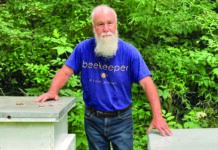It’s time to bring houseplants back indoors
Summer’s benefits may be dwindling as temperatures cool
MANHATTAN, Kan. – Cooler temperatures across much of Kansas and the Midwest signal a time to bring houseplants back indoors, said Kansas State University horticulture expert Ward Upham.
Many people move houseplants outdoors for the summer to give them better growing conditions and to help them recover from the stress of an indoor environment. But that summer boost ends as cooler fall days arrive.
“If plants haven’t been brought inside yet, now would be a good time as many areas of Kansas had nighttime temperatures in the 40s last week,” Upham said.
When bringing plants inside, inspect them first for insects or disease. Upham suggests “a sharp spray from a garden hose” to remove insects or mites from the foliage, Then, soak the pot in a tub of lukewarm water for 15 minutes to force out insects that may be in the potting soil.
Plants then need to adjust to their new lighting conditions.
“The question is how do we help houseplants acclimatize to the lower light levels inside,” Upham said. “They should be started out in an area of the home that receives plenty of light and then gradually moved to their permanent, darker location.”
That process, he added, may take between four to eight weeks depending on the degree of difference in light levels between the initial and final location of the plant.
“Understanding plant processes allows us to anticipate potential problems,” Upham said. “Acclimatization gives houseplants a greater chance of retaining leaves and avoiding the stress of completely replacing them.”
Upham and his colleagues in K-State’s Department of Horticulture and Natural Resources produce a weekly Horticulture Newsletter with tips for maintaining gardens and home landscapes. The newsletter is available to view online or can be delivered by email each week.
Interested persons can also send their garden- and yard-related questions to Upham at [email protected], or contact your local K-State Research and Extension office.
-30-
FOR PRINT PUBLICATIONS: Links used in this story
K-State Horticulture Newsletter, https://hnr.k-state.edu/extension/info-center/newsletters/index.html
K-State Research and Extension local offices, www.ksre.k-state.edu/about/stateandareamaps.html
K‑State Research and Extension is a short name for the Kansas State University Agricultural Experiment Station and Cooperative Extension Service, a program designed to generate and distribute useful knowledge for the well‑being of Kansans. Supported by county, state, federal and private funds, the program has county extension offices, experiment fields, area extension offices and regional research centers statewide. Its headquarters is on the K‑State campus in Manhattan. For more information, visit www.ksre.ksu.edu. K-State Research and Extension is an equal opportunity provider and employer.
Story by:
Pat Melgares
785-532-1160
For more information:
Ward Upham
785-532-6173




